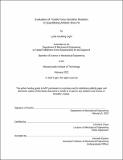Evaluation of Textile Force-Sensitive Resistors in Quantifying Athletic Shoe Fit
Author(s)
Light, Lydia Gaulding
DownloadThesis PDF (1.696Mb)
Advisor
Chase, Christina
Terms of use
Metadata
Show full item recordAbstract
A well-fitting shoe is valuable for many reasons, ranging from daily comfort to prevention of injuries. It is no surprise that a good fit is a driving factor in consumer purchase decisions, and is thus highly prioritized by shoe companies. However, ensuring consistent sizing and fit between shoes of varying shapes, layouts, and materials is challenging. Shoe companies use feedback from volunteer fit testers to adjust the design of new shoes before final production, but this process is time-consuming and provides only subjective information. There is need for a sensor-driven method for shoe companies that can provide accurate and objective data about the fit of a shoe.
There is extensive research on the value and methodology of quantifying shoe fit. Current approaches use dimensional comparison of foot and shoe shapes. However, this technique has its limitations, considering that both the shoe and foot deform differently based on shoe material and shoe-foot alignment. Ideally, fit would be measured when someone is wearing the shoe. There is precedent in research studies for measuring shoe-foot contact pressures with plastic thin-film pressure sensors and using this to successfully quantify shoe fit. However, the physical properties of plastic thin-film sensors are limited and the testing procedure for the sensors used in the studies does not translate well to an industry R&D setting. Instead, this paper investigates the design and use of textile pressure sensors for measuring shoe-foot contact pressures. Textile pressure sensors have been used in embedded socks for measuring plantar pressure in the research of gait analysis, but there is no literature yet on measuring upper foot pressures with textile pressure sensors for shoe fit analysis.
A design is proposed for a sensor system with textile pressure sensors that could be used in a shoe company to evaluate shoe fit. The sensor component specifically was investigated further with four prototypes of textile sensors – two prototypes were made with Amradield Stretch conductive fabric, and two were made with Adafruit Knit Jersey fabric; one prototype of each fabric was constructed with 2 ply conductive thread, while the remaining two used 3 ply. The four sensor prototypes were tested with a voltage probe in a voltage divider circuit using standardized weights. Pressures of 20-350 kPa were applied in long-term (45 sec) and short-term (10 sec) tests, and the sensor outputs were evaluated on precision, accuracy, range, and temporal consistency.
All four sensors demonstrated the expected inverse relationship between applied force and resistivity and had an adequate range and temporal precision for testing shoe fit. The results indicate that sensors made of Amradield Stretch performed better in accuracy and precision. There was no significant difference in sensor performance between those with 2 ply and those with 3 ply conductive thread.
Date issued
2022-02Department
Massachusetts Institute of Technology. Department of Mechanical EngineeringPublisher
Massachusetts Institute of Technology